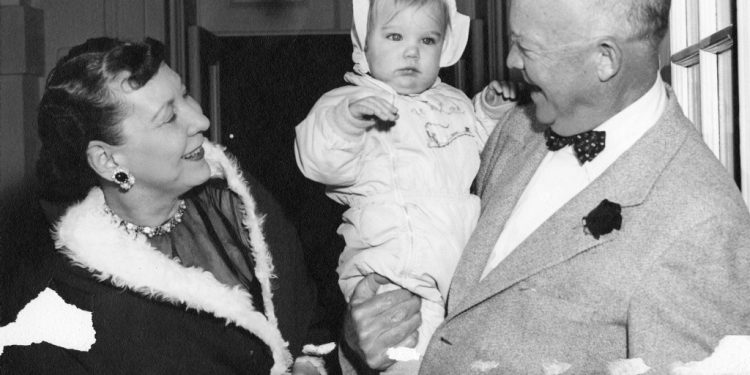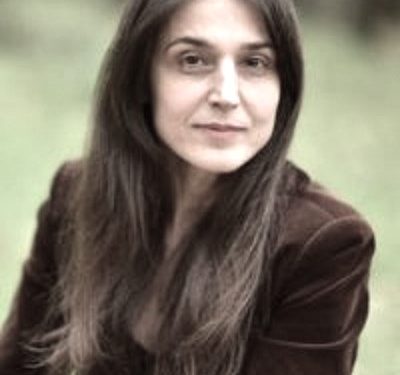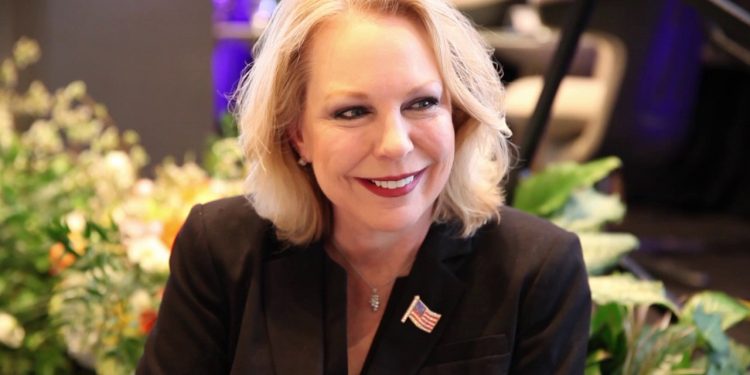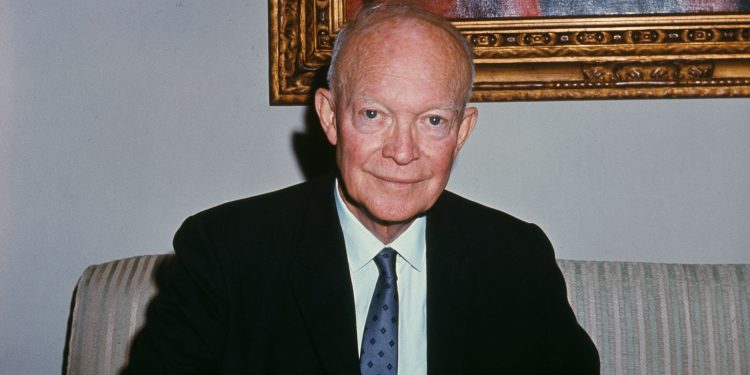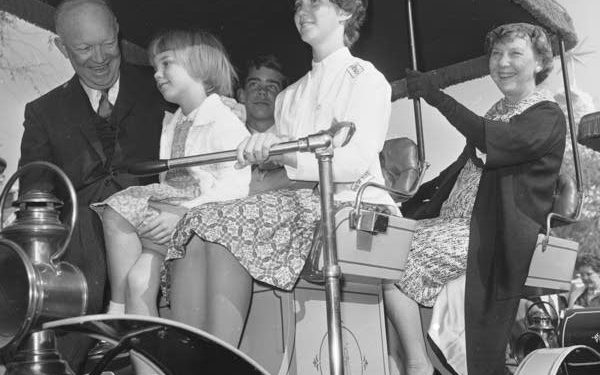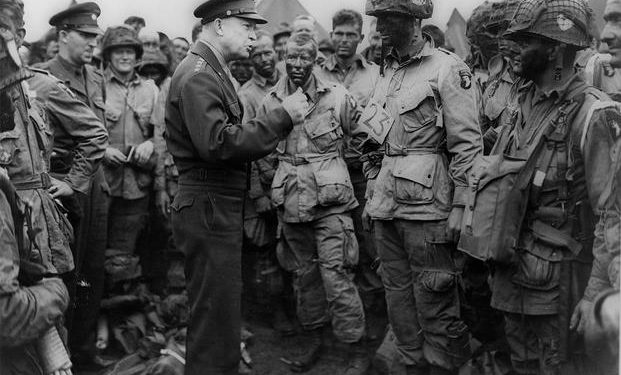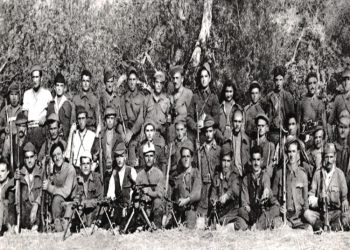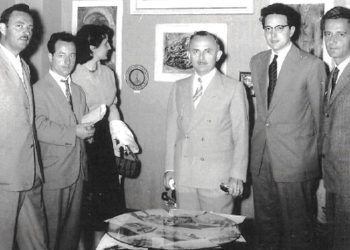Memorie.al / Mary Eisenhower was born in Washington, while her grandfather, Dwight Eisenhower, was in his first term as the 34th President of the United States. She was baptized in the Blue Room of the White House and grew up in Gettysburg, Pennsylvania. Her family had a home near the Eisenhower Farm, where President Eisenhower eventually retired in the final years of his life. Mary attended several schools in Pennsylvania until her father, John, was appointed U.S. ambassador to Belgium. She lived in Brussels with her family for three years after her grandfather’s death, from 1969 to 1972. She has worked as an administrator for a design firm.
As part of “People to People International,” she travels constantly from America to Africa, Europe, and Asia. One of the most unforgettable trips of her life, on the occasion of the 100th anniversary of her grandfather’s birth, Dwight Eisenhower, was to the D-Day invasion sites that marked the end of World War II. There, she met many veterans who had served in the army with him.
Mary Eisenhower had been leading this organization for several years, hoping to carry on the dream of her grandfather, who believed that a person’s conscience and civic consciousness are capable of doing more than governments and politics. Dwight Eisenhower founded “People to People” on September 11, 1956, with the aim of fostering international understanding among people of all nations and building a culture of peace where dignity and human rights are respected. It is no coincidence that “People to People” was created by a man who knew what war was and the devastation it brought.
This non-profit, cultural, and educational organization has had a branch in Tirana for several years, which was led by Genci Muçaj. In those years when the “People to People Europe” conference was organized for the first time in the Albanian capital, among the guests from all over the world, the executive director of “People to People International,” Mary Eisenhower, was present.
The Cold War President
Dwight D. Eisenhower (1890-1969), American general and the 34th President of America. The architect of the Allied intervention in Europe during World War II and the subsequent defeat of the German Nazis. As president, Eisenhower ended the war in Korea, but during his two terms (1953-1961), he provided few legislative benchmarks in foreign policy. The time of his leadership is remembered as a relatively calm period in the U.S. He had a meteoric rise as a professional soldier during the Second World War: lieutenant colonel in 1941 and general in 1945.
As the Supreme Commander of the Allied Expeditionary Force, he led the most powerful military, naval, air, and land forces ever assembled under one man. Eisenhower led the attack on the coast of Normandy in France on June 6, 1944, with the goal of defeating the Nazis, which was accomplished on May 8, 1945. He would succeed President Harry Truman. His ability as an expert and strategist proved that he could bring people together around a common goal.
Dwight Eisenhower was the president who calmed the U.S. fear of the spread of communism. His goal was to end the Cold War by de-escalating the situation between the Soviet Union and the U.S. In 1956, he created the “People to People” organization, headquartered in Kansas, whose programs have since involved 132 countries, operating with humanitarian programs, such as the recent tsunami disaster in Sri Lanka, operations for children in Iraq, for de-mining fields, etc.
Who is Mary Eisenhower?
I often ask myself this question. I am an ordinary person among extraordinary people in this excellent organization. I am lucky to be among them because I get to work with people, with volunteers who do great things every day.
Does this mean that Mrs. Eisenhower cannot see herself outside of “People to People”? What about your life?
I don’t think I have a life outside this organization. Absolutely not. I am in it. I am there 24/7, always with it.
Next year will be the 50th anniversary of “People to People.” You have adopted the slogan “One man’s vision, now a reality.” Has Dwight Eisenhower’s vision truly become a reality?
Unfortunately or fortunately, things in the world change every minute. However, one of his visions was the end of the Cold War, which has indeed disappeared. His idea was an excellent one: if people were together, without needing their governments, they would face problems much more easily. So, the moment people connect with each other, all nations find it easier to connect with each other. The power of ordinary people is very great, and in many cases, it has truly been achieved.
The Cold War has ended in many countries, but in others, it has simply changed its concept; it’s a different kind of war. However, “People to People” continues to work on the permanent philosophy for people, to extinguish the hotbeds of misunderstanding. This philosophy, when the situation is more critical at the moment we speak, is more important politically, as it is first worthwhile to understand a country’s culture and then to judge from a political point of view.
Albania has never been a factor during the Cold War, yet it experienced and had its own strong experience of this war within its borders. During this time, was this small country included in President Eisenhower’s vision?
I believe that all of Eastern Europe was certainly in his mind and vision. For the first time, I heard him talk about Albania. And I am sure, as far as I could understand at that age that Albania was on his mind also in terms of including this small country in the great philosophy of “People to People.” It was this idea of his that penetrated through people even into iron blocs like the Soviet Union or China and overcame those cultural and political barriers. This is a philosophy that we claim to continue today, with visits to different countries, with students creating strong bonds between people, regardless of which country they come from.
When did you get involved with Albania?
Despite being the granddaughter of the American president, until ’98, I was not a staff member; I was simply a volunteer, with all my desires. But the big change in my life happened in 1999, when I heard that in Albania, the first “People to People” groups were created. At that time, the Kosovo crisis occurred, and all the created groups managed to shelter 1,400 Kosovars. Then I came to Albania immediately and said that it no longer makes sense for me to be a volunteer, but to be a more active part. This was a motivation for me to continue this kind of policy, that is, the philosophy of Dwight Eisenhower. Then I came to Albania for the first time and fell in love with this country.
How do you remember your grandfather and President Eisenhower, and how did the family atmosphere with politics and diplomacy influence you?
At the time we are talking about, America was truly an isolated country. I knew my peers who simply went to and from school, who had never left their city, because of this isolation, because of the Cold War, the psychological warfare we had. In fact, I was a member of a generation that was not well-informed about the outside world. When my father was to be appointed ambassador, there were two possibilities: either to go to Brussels or to Pakistan. At that time, I knew where Pakistan was, but I didn’t know where Brussels was.
Then we lived in Brussels for three years. It was the moment I learned French very quickly and realized that my life would no longer have boundaries; my life would have another meaning. With the move to Brussels, while Americans felt isolated, our life took on another appearance, it was calmer. The world is and can be without borders. Then I took part in many actions, such as on the coast of Lisbon, which was polluted with oil. We went and cleaned the birds that were stained with oil and I realized that people are the same wherever they live.
On the occasion of the 100th anniversary of Eisenhower’s birth in 1990, you undertook a trip to the D-Day invasion sites and with your grandfather’s veterans.
This journey started from England, where the allied troops first set off, then to France, and to all the places where Dwight Eisenhower had trod and marched. At that time, I met war veterans, but not Americans. I saw some of the concentration camps. I understood exactly what that man had seen and experienced. It was truly the traces of war that inspired him and influenced the creation of “People to People.”
Going to Normandy and visiting the Nazi bunkers, the 18-19 year old soldiers, left me with indelible emotions. At that time, my son was 18 years old, and I thought he could also be in that position. When I saw the “window” of the bunker, the idea of a man with a gun in his hand, waiting for someone, horrified me. Then in the camp, I saw the crematoria where people were burned alive. What can a human do to another human! From the point of view of evil, it is very possible to do a lot.
But if it were seen differently from the philosophy of coexistence, imagine what a great force and what a product it would have, throughout the globe. We cannot deny what happened, but we must not allow it to happen again. In this context, what “People to People” aims for is to heal people’s hearts through cooperation, knowledge through cultural and educational programs, even to the de-mining of mined areas or peace camps with children from all over the world, to bring people closer.
Did you have such a mission in Iraq…?
Yes, yes. One of the programs was for the children of Iraq, where children from all over the world have come to help their peers in Iraq with school supplies. It is difficult for non-governmental organizations to work in Iraq because of the insecurity, but we have sent aid with the coalition troops.
What would President Eisenhower think, if he were alive, about the American attack on Iraq?
I think any war would upset him very much. Because he, like others, wanted the Second World War to stop, to end. The Nazis were our enemies. It was known at that time that we had an enemy that was visible, whereas today, we are at war in Iraq, but not with the Iraqis. This is a big difference. This is one of the many reasons we are concerned about the thousands of lives lost there every day.
In terms of fame and popularity, Eisenhower is very close to a legend like President Abraham Lincoln. What do you think was the key to his success?
He was an excellent man, and I say this as his granddaughter. The things that came from him came from his heart. He was a man with whom people felt very good. I want to tell a short story that he also recounted in his diary when he left the Oval Office in the White House. It was the time when John F. Kennedy came to lead the U.S. After lunch, my grandmother and grandfather left the office, got in the car to go to his city, and then he felt the special emotion of being a simple citizen, as he wished to be. A man among people. This is true.
Since the missions of “People to People” are also for developing countries like Albania, what do you think is special about this country in the global family?
Developing countries are not our only focus. We are in 132 countries around the world. Albania is a case to be taken as an example, a special case where a great truth of this philosophy can be accurately understood. This country is on the main list; it is in our attention. Besides this, it is part of the decision-making on the board of “People to People.” / Memorie.al




